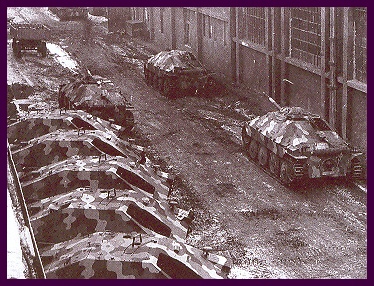Alanmac;
"Sir":
Huh.
[qoute] As regards the three colour scheme. This was applied at factory level, during the production process and as you can see used precut stencils to create the patterns. I doubt very much if they went out of the factory in a Rot Oxide or other unfinished state as has been suggested.
In fact Bob, perhaps you could quote the source of your information that leads you to make this statement/assumption.[quote]
Quote
"In almost every case up to the the end of the war, Hetzers probably came off the assembly lines and paint shop wearing at least a base coat of gelb, or later, olive-grun on the uppers. With paint shortages, the lower hull (but maybe not the wheels) may have remained rotoxide primer." [quote]
???
Seems that you agree with me that 1) those Hetzers came out NOT wearing (exposed) rotoxide - at least on top - up to some point... as doc'd by your picture with the stencil tri-colour- and 2), STRONGLY IMPLICITLY, that they DID come out wearing at least a base-coat of some colour! That tri-colour needed to start somewhere!
Are you perhaps at issue with my "assumption" (my stated opinion) that Hetzers PROBABLY came off the line wearing at least an upper-surfaces base-coat other than rotoxide right up to war's end, in MOST cases? Or is it about my "assumption" that late-war Hetzers MAY have had EXPOSED rotoxide on lower hull surfaces (but not on the wheels) (As has been loudly claimed for various other late-war German vehicles)? Or maybe about my "assumption" that such appearance would putatively reflect a (often claimed) shortage of paint in late war?
I'm OK with all that! I am stating my "ASSUMPTION" (my OPINION, more correctly) - not a "FACT". I am not an expert on German Armour production and don't pretend to be. I DO have an OPINION about it, having read quite a lot over a few decades on the subjects of German military vehicles and their production.
You did ask for me to cite my sources for my "assumption". I must apologize as I didn't bother writing it all down! I frankly wasn't worried that I needed to post technical references to support every opinion I might offer! I save that for my alter-ego as a research scientist and technical projects developer in gov.
Still, I do respect your request and your interest.
I remain, however, prefectly confident in my stated "assumptions" - my OPINION-: Paint schemes and regs did vary over time, base-coats were typically applied to all Hetzers, and rotoxide was probably rarely seen on finished in-service vehicles, and if then, probably only on the lower hull and behind wheels. And yes, paint was in increasingly short and erratic supply as the war wound down.
To be sure, this is MY OPINION about something seems we are all interested in.
As the subsequent poster (tskross) provided:
[quote] German camo is always a contentious issue though so I wouldn't worry obsessively about it as long as your pattern and colors are within the prescribed dates there will always be someone to back you up in your choices (and someone to argue against them)! [quote].
A sentiment I fully agree with.
Cheers!
Bob



























